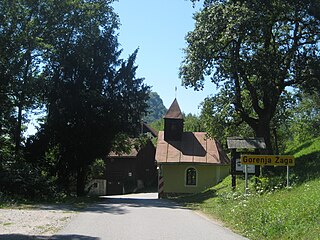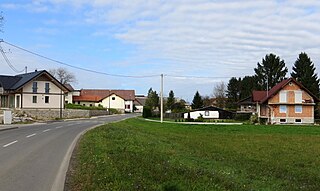
Dolenja Žetina is a dispersed settlement below Mount Blegoš in the Municipality of Gorenja Vas–Poljane in the Upper Carniola region of Slovenia. It is a clustered village on a low terrace in the foothills of Mount Koprivnik. There are many springs in the area and there are abandoned mills in the two ravines below the settlement.

Dolenja Vas is a village southwest of Cerknica in the Inner Carniola region of Slovenia.

Adlešiči is a settlement on the left bank of the Kolpa River in the Municipality of Črnomelj in the White Carniola area of southeastern Slovenia. The area is part of the traditional region of Lower Carniola and is now included in the Southeast Slovenia Statistical Region. It also encompasses a hamlet to the east near the bank of the Kolpa River called Nabrežci, also known as Nabreško Selo.

Zilje is a settlement above the left bank of the Kolpa River in the Municipality of Črnomelj in the White Carniola area of southeastern Slovenia. The area is part of the traditional region of Lower Carniola and is now included in the Southeast Slovenia Statistical Region.

Spodnja Bilpa is a small settlement on the left bank of the Kolpa River in the Municipality of Kočevje in southern Slovenia. The area is part of the traditional region of Lower Carniola and is now included in the Southeast Slovenia Statistical Region.

Gorenja Žaga is a small settlement on the left bank of the Kolpa River north of Kostel in southern Slovenia. The area is part of the traditional region of Lower Carniola and is now included in the Southeast Slovenia Statistical Region.

Negastrn is a settlement north of Moravče in central Slovenia. Traditionally the area was part of the Upper Carniola region. It is now included with the rest of the Municipality of Moravče in the Central Slovenia Statistical Region. The settlement includes the hamlets of Spodnja Vas, Zgornja Vas, and Podoreh.

Stare Žage is a settlement in the Municipality of Dolenjske Toplice in Slovenia. The area is part of the historical region of Lower Carniola. The municipality is now included in the Southeast Slovenia Statistical Region.

Spodnje Blato is a settlement just east of Grosuplje in central Slovenia. The area is part of the historical region of Lower Carniola and is now included in the Central Slovenia Statistical Region.

Rog is a remote abandoned settlement in the Municipality of Kočevje in southern Slovenia. The area is part of the traditional region of Lower Carniola and is now included in the Southeast Slovenia Statistical Region. Its territory is now part of the village of Trnovec.

Jelenja Vas is a hamlet of the village of Štalcerji in the Municipality of Kočevje in southern Slovenia. Formerly, it was an independent settlement. The area is part of the traditional region of Lower Carniola and is now included in the Southeast Slovenia Statistical Region.

Gorenja Bukova Gora is a remote abandoned settlement in the Municipality of Kočevje in southern Slovenia. The area is part of the traditional region of Lower Carniola and is now included in the Southeast Slovenia Statistical Region. Its territory is now part of the village of Bukova Gora.

Srednja Bukova Gora is a remote abandoned settlement in the Municipality of Kočevje in southern Slovenia. The area is part of the traditional region of Lower Carniola and is now included in the Southeast Slovenia Statistical Region. Its territory is now part of the village of Bukova Gora.

Spodnja Bukova Gora is a remote abandoned settlement in the Municipality of Kočevje in southern Slovenia. The area is part of the traditional region of Lower Carniola and is now included in the Southeast Slovenia Statistical Region. Its territory is now part of the village of Bukova Gora.

Gorenja Vas is a formerly independent settlement in the Municipality of Ribnica in southern Slovenia. It is now part of the town of Ribnica. The area is part of the traditional region of Lower Carniola and is now included in the Southeast Slovenia Statistical Region. The settlement included the hamlet of Lepovče to the east, on the other side of the railroad tracks.

Spodnja Hrušica is a formerly independent settlement southeast of the capital Ljubljana in central Slovenia. It belongs to the City Municipality of Ljubljana. It was part of the traditional region of Lower Carniola and is now included with the rest of the municipality in the Central Slovenia Statistical Region.

Spodnja Zadobrova is a formerly independent settlement in the eastern part of the capital Ljubljana in central Slovenia. It was part of the traditional region of Upper Carniola and is now included with the rest of the municipality in the Central Slovenia Statistical Region.

Zgornja Zadobrova is a formerly independent settlement in the eastern part of the capital Ljubljana in central Slovenia. It was part of the traditional region of Upper Carniola and is now included with the rest of the municipality in the Central Slovenia Statistical Region.

Hreljin is an uninhabited settlement on the left bank of the Kolpa River in the Municipality of Kočevje in southern Slovenia. The area is part of the traditional region of Lower Carniola and is now included in the Southeast Slovenia Statistical Region.

Kuželič is a small uninhabited settlement west of Vas in the Municipality of Kostel in southern Slovenia. The area is part of the traditional region of Lower Carniola and is now included in the Southeast Slovenia Statistical Region.
















